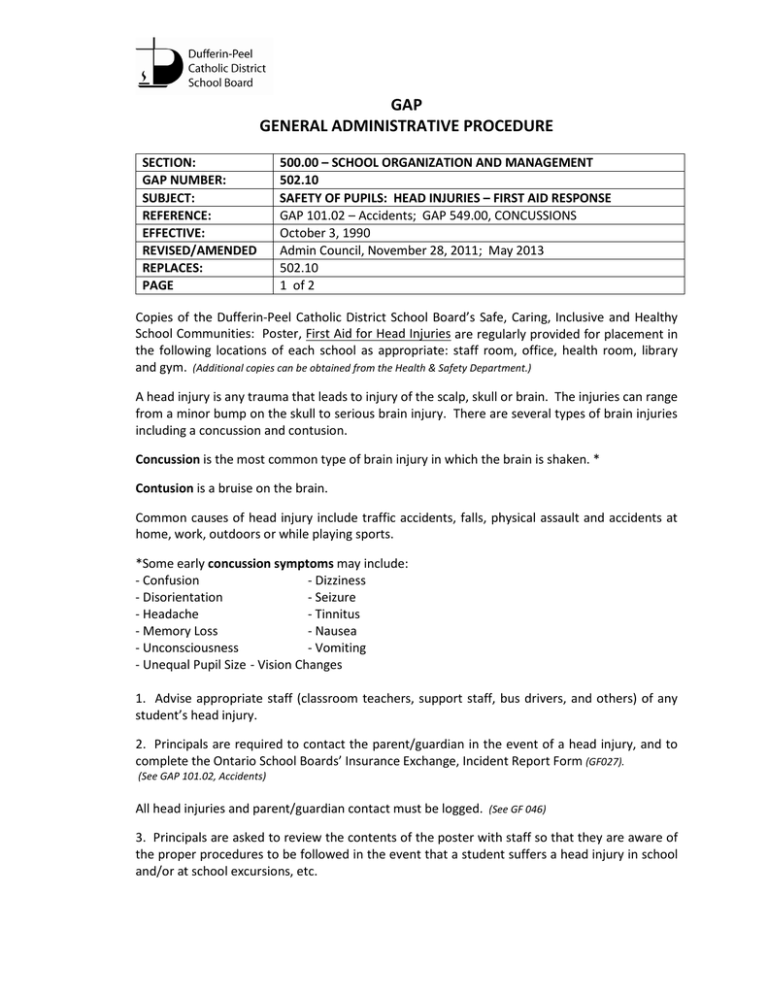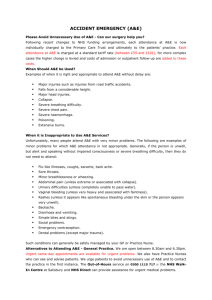GAP GENERAL ADMINISTRATIVE PROCEDURE
advertisement

GAP GENERAL ADMINISTRATIVE PROCEDURE SECTION: GAP NUMBER: SUBJECT: REFERENCE: EFFECTIVE: REVISED/AMENDED REPLACES: PAGE 500.00 – SCHOOL ORGANIZATION AND MANAGEMENT 502.10 SAFETY OF PUPILS: HEAD INJURIES – FIRST AID RESPONSE GAP 101.02 – Accidents; GAP 549.00, CONCUSSIONS October 3, 1990 Admin Council, November 28, 2011; May 2013 502.10 1 of 2 Copies of the Dufferin-Peel Catholic District School Board’s Safe, Caring, Inclusive and Healthy School Communities: Poster, First Aid for Head Injuries are regularly provided for placement in the following locations of each school as appropriate: staff room, office, health room, library and gym. (Additional copies can be obtained from the Health & Safety Department.) A head injury is any trauma that leads to injury of the scalp, skull or brain. The injuries can range from a minor bump on the skull to serious brain injury. There are several types of brain injuries including a concussion and contusion. Concussion is the most common type of brain injury in which the brain is shaken. * Contusion is a bruise on the brain. Common causes of head injury include traffic accidents, falls, physical assault and accidents at home, work, outdoors or while playing sports. *Some early concussion symptoms may include: - Confusion - Dizziness - Disorientation - Seizure - Headache - Tinnitus - Memory Loss - Nausea - Unconsciousness - Vomiting - Unequal Pupil Size - Vision Changes 1. Advise appropriate staff (classroom teachers, support staff, bus drivers, and others) of any student’s head injury. 2. Principals are required to contact the parent/guardian in the event of a head injury, and to complete the Ontario School Boards’ Insurance Exchange, Incident Report Form (GF027). (See GAP 101.02, Accidents) All head injuries and parent/guardian contact must be logged. (See GF 046) 3. Principals are asked to review the contents of the poster with staff so that they are aware of the proper procedures to be followed in the event that a student suffers a head injury in school and/or at school excursions, etc. GAP 502.10 – Page 2 The following provides the contents/directions of the Poster: First Aid for Head Injuries FIRST AID FOR HEAD INJURIES IN THE CASE OF EVERY HEAD INJURY, SEEK IMMEDIATE HELP ALWAYS INFORM PARENT(S)/GUARDIAN(S) OF EVERY HEAD INJURY RESPONSE TO ACCIDENT Always suspect a spinal injury. Any blow to the head strong enough to cause unconsciousness may also cause a cervical spine injury, so treat accordingly. Do not move a casualty who may have a spinal injury, unless it is necessary to get him or her out of danger. A casualty who is conscious should be advised not to move. Loosen tight clothing. GIVE NOTHING BY MOUTH Never leave an unconscious person alone – MONITOR AIRWAY, BREATHING, CIRCULATION Never leave an unconscious person on his or her back unless injuries prevent you from moving them. If it is necessary to leave the unconscious person with a suspect spinal injury unattended, immobilize the casualty’s neck and roll the casualty into the RECOVERY POSITION. SEEK IMMEDIATE MEDICAL HELP IF BLEEDING – If the person is bleeding from openings like the nose, mouth or ears, do not stop the bleeding. Position the casualty to permit free drainage. Cover the wound lightly to prevent infection. Depending on the circumstances and cause of injury – if it’s a simple nose-bleed, pressure must be applied to stop the bleeding. Tilt casualties head forward. If bleeding occurs from the facial or scalp wounds, treat it as a normal injury. Apply pressure to the bleeding area with the cleanest material available. The hand must be used if nothing else is immediately available. Remember to treat all casualties for shock: keep them warm and at rest, re-assure them and monitor the breathing and level of consciousness. SEEK IMMEDIATE MEDICAL HELP THE ADVICE AND ASSISTANCE OF THE FIRST AID TRAINED STAFF MEMBER SHOULD BE SOUGHT FOR EVERY HEAD INJURY. REFER TO GAP 502.10 and GAP 101.02 FOR ADDITIONAL INFORMATION. .....



